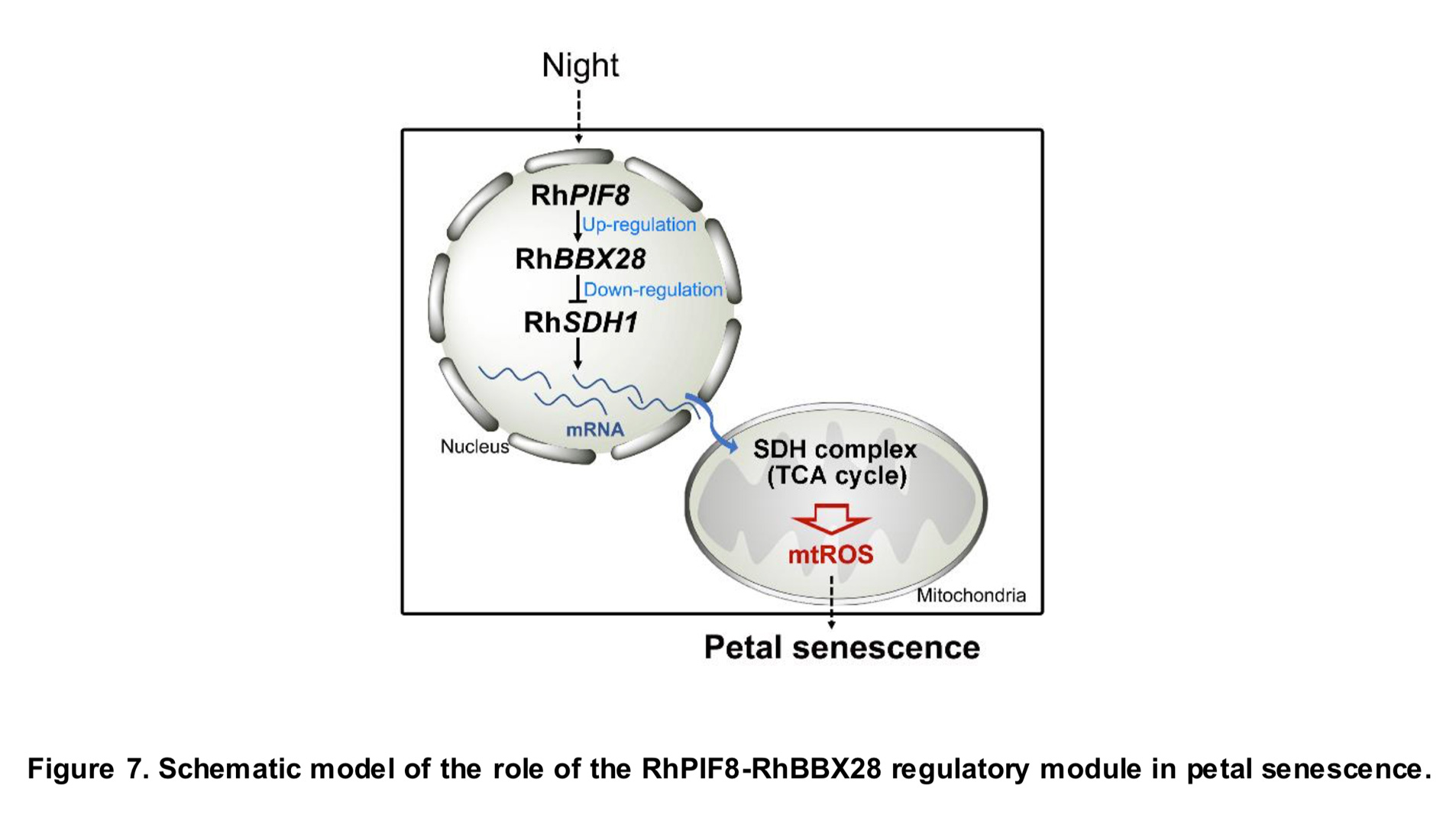博文
Plant Cell:玫瑰PIF8-BBX28模块通过夜晚线粒体ROS稳态介导花瓣的衰老控制
||
The circadian-controlled PIF8-BBX28 module regulates petal senescence in rose flowers by governing mitochondrial ROS homeostasis at night
第一作者:Yi Zhang
第一单位:中国农业大学
通讯作者:Nan Ma
Abstract
背景回顾:Reactive oxygen species (ROS) are unstable reactive molecules that are toxic to cells. Regulation of ROS homeostasis is crucial to protect cells from dysfunction, senescence and death. In plant leaves, ROS are mainly generated from chloroplasts and are tightly temporally restricted by the circadian clock.
提出问题:However, little is known about how ROShomeostasis is regulated in non-photosynthetic organs, such as petals.
结果1-玫瑰花瓣中H2O2水平存在生物节律:Here, we showed that H2O2 levels exhibit typical circadian rhythmicity in rose (Rosa hybrida) petals, consistent with the measured respiratory rate.
结果2-关键基因鉴定:RNA-seq and functional screening identified a B-box gene, RhBBX28, whose expression was associated with H2O2 rhythms.
结果3-RhBBX28功能验证:Silencing RhBBX28 accelerated flower senescence and promoted H2O2 accumulation at night in petals, while overexpression of RhBBX28 had the opposite effects.
结果4-RhBBX28下游:RhBBX28 influenced the expression of various genes related to respiratory metabolism, including the TCA cycle and glycolysis, and directly repressed the expression of SUCCINATE DEHYDROGENASE 1, which plays a central role in mitochondrial ROS homeostasis.
结果5-RhBBX28上游:We also found that PHYTOCHROME INTERACTING FACTOR8 (RhPIF8) could activate RhBBX28 expression to control H2O2levels in petals and thus flower senescence.
结论:Our results indicate that the circadian- controlled RhPIF8-RhBBX28 module is a critical player that controls flower senescence by governing mitochondrial ROS homeostasis in rose.

摘 要
活性氧物质ROS是不稳定的活性分子,对于细胞来说是有毒的。ROS稳态的调控对于保护细胞免受功能紊乱、衰老和死亡是非常重要的。在植物的叶片中,ROS通常由叶绿体产生,并且严格受到生物钟的时间限制。但是,对于非光合器官中ROS内稳态的调控机制还不清楚,比如说花瓣组织。本文中,作者发现玫瑰花瓣中的过氧化氢水平存在典型的生物节律,并与测得的呼吸速率保持一致。通过RNA-seq和功能筛选,作者鉴定到了一个B-box基因RhBBX28,该基因的表达与过氧化氢的节律存在关联。沉默RhBBX28基因会加速玫瑰花的衰老,并且会增加花瓣在夜间过氧化氢的积累;而过表达RhBBX28基因具有相反的作用。RhBBX28能够影响多个与呼吸代谢相关基因的表达,包括TCA循环和糖酵解;另外,RhBBX28还能够直接抑制一个在线粒体ROS稳态中发挥核心作用的基因SUCCINATE DEHYDROGENASE 1的表达。作者还发现玫瑰光敏色素互作因子RhPIF8能够激活RhBBX28基因的表达,从而控制花瓣中过氧化氢的水平,最终控制玫瑰花朵的衰老。本文的结果揭示了由生物钟控制的RhPIF8-RhBBX28模块通过线粒体ROS内稳态,在玫瑰花衰老的调控中发挥重要作用。
通讯作者
** 马男 **
个人简介:
1997-2001年,中国农业大学,学士;
2001-2006年,中国农业大学,博士。
研究方向:月季花朵开放和衰老的分子生理机制。
doi: https://doi.org/10.1093/plcell/koab152
Journal: Plant Cell
Published date: May 27, 2021
https://blog.sciencenet.cn/blog-3158122-1288713.html
上一篇:Molecular Plant:拟南芥茎尖分生组织的高温胁迫记忆
下一篇:Cell:水稻泛基因组揭示“隐藏”的遗传变异
全部作者的其他最新博文
- • Plant Physiology:CsMADS3促进柑果中的叶绿素降解和类胡萝卜素合成(华中农业大学)
- • Molecular Plant:LBD11-ROS反馈调节作用于拟南芥的维管形成层增殖和次生生长(浦项科技大学)
- • Science Advances:根结线虫通过调控植物的CLE3-CLV1模块,促进侵染进程(日本熊本大学)
- • Nature Communications:油菜素内酯参与植物营养生长期转变的分子机制解析(浙江农林大学)
- • Current Biology:光合作用产生的蔗糖驱动侧根“生物钟”(德国弗莱堡大学)
- • PNAS:花同源异型基因在叶中被抑制、花中被激活的分子机制(南卡罗来纳大学)